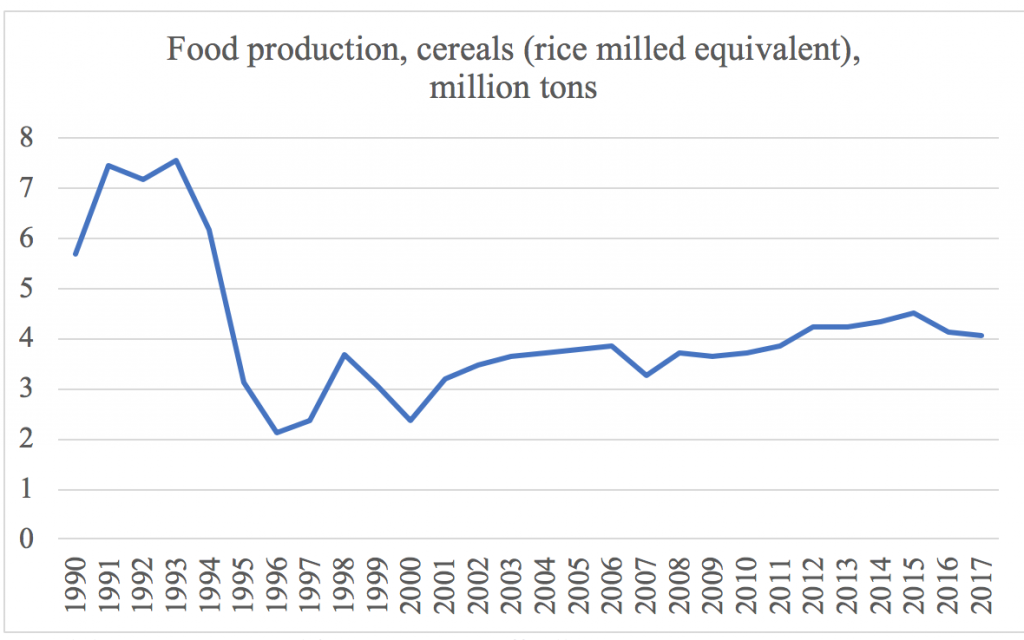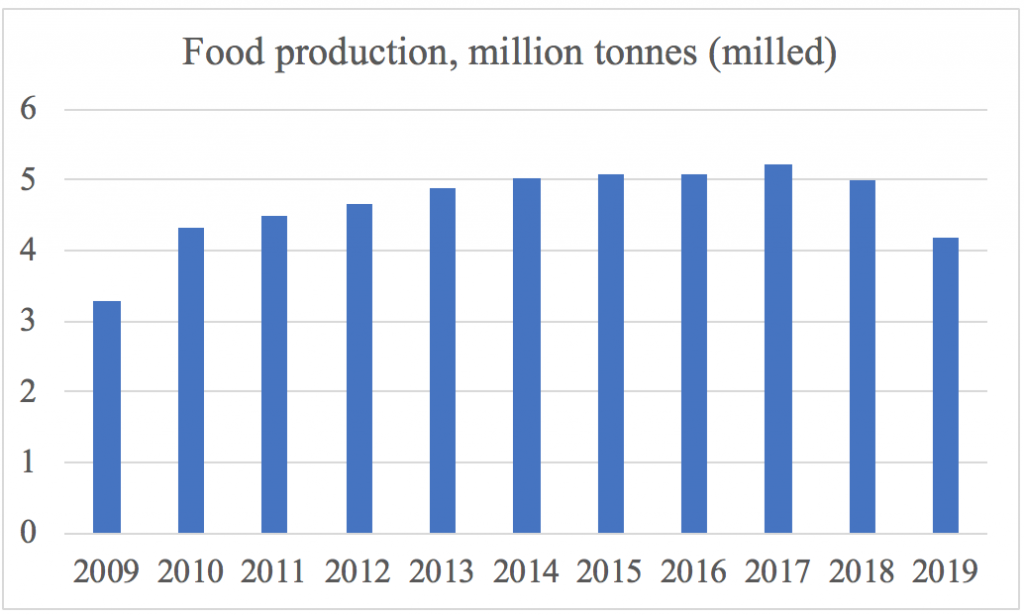(Source: Simon Denyer, “North Korea floods kill 22, approach nuclear reactor — but Kim doesn’t want help,” Washington Post, August 14th, 2020.)
Monsoon rains and strong winds have led to substantial damage in the grain-producing regions of North Korea’s west coast, leading to predictions that the country will face a poor harvest this year, Daily NK has learned.
“North Hamgyong Province is the center of the country’s corn production, but an [internal] statistical report on Aug. 3 said that 42% of terraced cornfields and farmland near rivers had been either washed away or flooded,” a source in North Hamgyong Province told Daily NK on Monday. “The report did not include data about farms tilled by individual farmers. Including those farms would mean that the actual damage [to farmland] is even greater.”
Regarding the situation in nearby South Hamgyong Province, the source told Daily NK that “South Hamgyong Province is the home of rice [production], but midway through the monsoon season approximately 30% of farmland has already been flooded.”
According to the source, the harvest this year in the region was actually better than last year until the start of the monsoon season. He pointed out, however, that “rice plants became inundated with water just as they were being fertilized, so there is talk that farmers will barely be able to meet the government’s autumn quota for military rice [rice going to the military].”
Farms in the coastal areas of South Pyongan Province have also suffered from flooding and crop damage, a source in the region said.
“There has been substantial damage to crops, with monsoon rains flooding fields in several areas near the central west coast and strong winds blowing over corn plants that were just beginning to mature,” the source said. “Farmland stretching across thousands of jongbo in Jungsan and Pyongwon have been damaged by salt water, which means we can’t expect normal harvest levels this year.”
One jongbo is equivalent to around 9,917 square meters.
Areas near Nampo, including Onchon and Gangso, were hit by monsoon rains and strong gales that felled telephone poles and roadside trees, according to the source, who also reported that dozens of farm houses have collapsed and their now-homeless former occupants have been evacuated to other structures on farms, including cultural halls and rooms used by work units.
RAPID CLEAN UP EFFORTS IN UNPA COUNTY
After North Korean leader Kim Jong Un visited North Hamgyong Province’s Unpa County to see the devastation wrought by a dyke that burst open, efforts to cleanup the damage are rapidly underway, a source in the area told Daily NK.
“The Supreme Leader came to inspect [the damage] in Unpa County personally, and the province has dispatched a storm trooper contingent made up of 300 party members along with another storm trooper unit made up of around 500 Kimsungilist-Kimjongilist Youth League members,” the source said.
“The authorities have also mobilized workers from various businesses in the province while [Unpa County] farmers, along with village and district-level inminban [North Korea’s lowest administrative unit], are working to process barren soil, build embankments, restore farmland and repair people’s homes,” he added.
People who have lost their homes in the area have been housed in cultural halls, guest houses, local inns or the houses of friends; however, county authorities have forced many to engage in the cleanup efforts, according to the source.
The military has mobilized soldiers to the area, including 280 soldiers selected from units under the “August 15 Training Center” along with two battalions from the 25th Brigade under Bureau 7 (a military engineers unit). The battalions have reportedly brought along mechanized equipment for the cleanup efforts. The soldiers have set up waterproof tents and are living in the area while cleaning up the damage.
On Aug. 7, Rodong Sinmun and other state-run media reported that Kim Jong Un visited Unpa County and ordered the construction of a new farming village to accommodate 800 families, as well as the release of grain reserves and emergency supplies for victims and those performing relief work.
The source confirmed that the authorities had ordered the completion of housing blocks accommodating two families each by Nov. 10.
“Military units along with the storm trooper units made up of provincial party members and members of the Youth League will build the houses,” the source said. “Overall responsibility for the project is held by both the Cabinet’s vice premier and the North Hwanghae Province Party Committee Director, and progress reports will be sent to the Supreme Leader.”
AN UNPA COUNTY-FOCUSED RELIEF EFFORT
North Korea is also holding a nationwide campaign to raise funds for the relief work and the construction of new houses in Unpa County, according to the source.
“Even though the damage [by the monsoon rains] is not limited to Unpa County, inminban around the country have been told that they must offer assistance to the area by sending support packages for affected residents and soldiers engaged in construction work by Aug. 13,” the source told Daily NK.
While the required contribution differs by region, the figure is believed to be KPW 20,000 for each household in Pyongyang’s Mangyongdae District and KPW 10,000 or 2.5 kilograms of rice for each family in Kaechon, South Pyongan Province. Families in Sariwon, North Hwanghae Province, have been told to either contribute KPW 15,000 per household or provide labor in lieu of a monetary payment.
On Monday, Korea Central News Agency and other state-run media reported that vehicles carrying the reserve grain sent by Kim Jong Un had arrived in Unpa County. The article was accompanied by photos of residents welcoming the delivery.
“This [kind of delivery] happened once before during the General [Kim Jong Il]’s reign, but people were deeply moved because it is the first time they have been provided with such a gift under Kim Jong Un,” the source said, adding, “Those in other regions are envious.”


